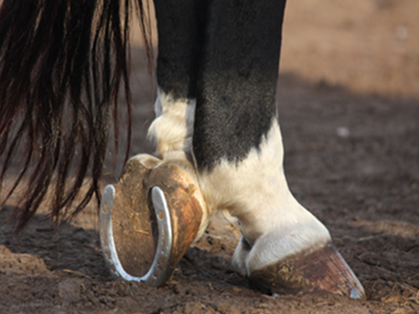Diet or Trim – What’s More Important for Hoof Health?
 by: Eleanor M. Kellon, VMD for Equine Cushing’s and Insulin Resistance Group Inc.
by: Eleanor M. Kellon, VMD for Equine Cushing’s and Insulin Resistance Group Inc.
If you ask me which is more difficult for an owner to get right, I’d say the trim. If you ask a talented hoof professional, they would usually say diet. It’s actually a trick question. Both are critical, and one can’t produce a healthy hoof without the other.
There is an acronym I use for reminding owners what needs to be done to effectively treat a laminitic horse – DDT.
D – Diagnosis, to identify and remove the cause.
D – Diet, correct calories, protein, essential fatty acids, vitamins and mineral balance.
T – Trim, to make the “shoe” (hoof capsule and solar structures) fit the “foot” (bones).
Cut corners on any of these and you won’t get good results. With hoof issues other than laminitis, which do not have a systemic disorder cause, it is still equally important to address both the diet and the trim.
Trim is critical whether the horse is shod or not. As above, the goal of the trim should be to make the external structures conform to the interior. A physiologically correct trim is a work of art which sculpts and molds the hoof to the proper configuration. Common problems such as flares, cracks, white line stretching, flat soles/distal descent, navicular irritation, underrun heels, and coffin joint disease all have a major component of incorrect trimming.
On the other hand, nutrition plays a huge role in hoof quality. Poor nutrition can sabotage trimming efforts to restore hoof form. An example I see often is the foot with a long toe and underrun heel. This is the equivalent of you trying to walk in shoes two sizes too big in the toe, but with the back half of the heel missing.
A long toe always creates tearing forces on the laminae. When the tissue is weak to begin with, toe flaring and laminar damage is worsened. Similarly, poor horn quality means heels will collapse forward more easily.
This is a quick rundown of key nutrients and their effects:
Protein: The hoof is over 90% protein. The amino acid methionine is particularly important because sulfur-sulfur bonds impart significant strength and sulfur amino acid levels are dropping in many forages.
Zinc: Deficiency has been linked to slow growth, thin walls, weak white line connections, weak horn.
Copper: Inadequate copper or low copper + zinc has been associated with solar hemorrhage, thrush, cracks, abscesses, soft horn.
Biotin: Supports normal growth rate and improves connections.
These are only some of the more familiar big players. Because of the high metabolic rate of cells forming the hoof wall, virtually every vitamin and mineral has a role to play. However, more is not better and the key to growing healthy feet is identifying and correcting deficiencies and imbalances in the individual diet.
Good hoof supplements do exactly that, and so would a general “balancer” or vitamin/mineral supplement that actually matched the profile of vitamins and minerals your horse needs in his diet, without providing too much of things he doesn’t need added.
A correct diet will eliminate the need for a hoof supplement – but it won’t substitute for a good physiological trim. Get both of these right and you’re on your way to healthy feet.
About ECIR Group Inc.
Started in 1999, the ECIR Group is the largest field-trial database for PPID and EMS in the world and provides the latest research, diagnosis, and treatment information, in addition to dietary recommendations for horses with these conditions. Even universities do not and cannot compile and follow long term as many in-depth case histories of PPID/EMS horses as the ECIR Group.
In 2013 the Equine Cushing’s and Insulin Resistance Group Inc., an Arizona nonprofit corporation, was approved as a 501(c)3 public charity. Tax deductible contributions and grants support ongoing research, education, and awareness of Equine Cushing’s Disease/PPID and EMS.
THE MISSION of the ECIR Group Inc. is to improve the welfare of equines with metabolic disorders via a unique interface between basic research and real-life clinical experience. Prevention of laminitis is the ultimate goal. The ECIR Group serves the scientific community, practicing clinicians, and owners by focusing on investigations most likely to quickly, immediately, and significantly benefit the welfare of the horse.










